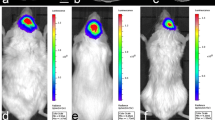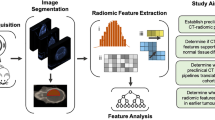Abstract
Purpose
The purpose of this paper is to validate a rapid and cost-effective ex vivo technique, microCT-based virtual histology, as an alternative to MRI imaging for assessing the therapeutic response in genetically engineered mouse models of cancer.
Procedures
All animal procedures were conducted in accordance with the Guidelines for the Care and Use of Laboratory Animals and were approved by the Institutional Animal Care and Use Committee (IACUC) at the University of Texas Health Science Center at San Antonio. MRI imaging was performed on 6-week-old, bortezomib-treated genetically engineered Patched1, p53 mice that recapitulate the characteristics of human medulloblastoma. After MRI scans, the same mice were euthanized to collect brain or spine samples for virtual histology staining followed by microCT scanning.
Results
Nine-micrometer resolution ex vivo micro X-ray computed tomography (microCT)-based virtual histology images were qualitatively reflective of high-field live animal images obtained with magnetic resonance imaging (MRI) and histopathology. Cerebellar volumes on microCT-based virtual histology correlated closely with MRI cerebellar volumes (R = 0.998). MRI and microCT-based virtual histology both indicated a significant difference between cerebellar volumes of untreated and treated mice (p = 0.02 and p = 0.04, respectively). The ex vivo microCT method also allowed a 7,430-fold improvement in voxel resolution (voxel volume of 729 μm3 for 9-μm isometric resolution microCT vs. 5,416,800 μm3 for 400 × 111 × 122 μm resolution MRI) at a 28% cost savings ($400 vs. $555 per animal).
Conclusion
The ex vivo, en bloc technique of microCT-based virtual histology matched MRI in reflecting histopathology. MicroCT-based virtual histology proved to be a more cost-effective technique and less labor-intensive. On the other hand, MRI provides ability to perform in vivo imaging, faster scanning and lower radiation dose by sacrificing the spatial resolution. Thus, both in vivo MRI and ex vivo microCT-based virtual histology are effective means of quantitatively evaluating therapeutic response in preclinical models of cerebellar tumors including the childhood cancer, medulloblastoma.




Similar content being viewed by others
References
Koeller KK, Rushing EJ (2003) From the archives of the AFIP: medulloblastoma: a comprehensive review with radiologic-pathologic correlation. Radiographics 23:1613–1637
Roberts RO, Lynch CF, Jones MP, Hart MN (1991) Medulloblastoma: a population-based study of 532 cases. J Neuropathol Exp Neurol 50:134–144
Taniguchi E, Cho MJ, Arenkiel BR et al (2009) Bortezomib reverses a post-translational mechanism of tumorigenesis for patched1 haploinsufficiency in medulloblastoma. Pediatr Blood Cancer 53:136–144
Samano AK, Ohshima-Hosoyama S, Whitney TG et al (2009) Functional evaluation of therapeutic response for a mouse model of medulloblastoma. Transgenic Res. 2010 Jan 27.
Johnson JT, Hansen MS, Wu I et al (2006) Virtual histology of transgenic mouse embryos for high-throughput phenotyping. PLoS Genet 2:e61
Martinez HG, Prajapati SI, Estrada CA et al (2009) Images in cardiovascular medicine: microscopic computed tomography-based virtual histology for visualization and morphometry of atherosclerosis in diabetic apolipoprotein e mutant mice. Circulation 120:821–822
Palombella AL, Dutcher SK. (1998) Identification of the gene encoding the tryptophan synthase beta-subunit from Chlamydomonas reinhardtii. Plant Physiol. 1998 Jun;117(2):455–64
Hideshima T, Mitsiades C, Akiyama M et al (2003) Molecular mechanisms mediating antimyeloma activity of proteasome inhibitor PS-341. Blood 101(4):1530–1534
Acknowledgments
C.K. is a member of the Cancer Therapy and Resource Center (2P30CA054174-17). This work was supported by a grant from the National Brain Tumor Society.
Disclosures
C.K. is co-founder of Numira Biosciences (www.numirabio.com), which licenses microCT-based virtual histology from UTHSCSA for commercial applications.
Author information
Authors and Affiliations
Corresponding author
Additional information
Significance: MicroCT-based virtual histology represents a versatile quantitative imaging method for anatomical imaging of the neuro-axis in preclinical models.
An erratum to this article is available at http://dx.doi.org/10.1007/s11307-017-1079-5.
Electronic Supplementary Materials
Below is the link to the electronic supplementary material.
ESM 1
(DOC 23 kb)
Supplementary Fig. 1
Leptomeningeal metastasis. Comparison between microCT-based virtual histology and traditional histopathology for a Ptc1 F1-2m/WT Trp53 F2-10/F2-10 Pax7 ICNm/WT mouse spine. (a) microCT-based virtual histology image of the entire spine. (b) Magnification of the superior spine focusing on a leptomeningeal metastasis, shown by dashed rectangle. a, p correspond to anterior and posterior side of the animal, respectively. (c,d) Photomicrographs for hematoxylin and eosin of the same spine. m, c, n, and b denote metastasis, cord, nerve and bone, respectively.(241 kb)
Rights and permissions
About this article
Cite this article
Prajapati, S.I., Kilcoyne, A., Samano, A.K. et al. MicroCT-Based Virtual Histology Evaluation of Preclinical Medulloblastoma. Mol Imaging Biol 13, 493–499 (2011). https://doi.org/10.1007/s11307-010-0372-3
Published:
Issue Date:
DOI: https://doi.org/10.1007/s11307-010-0372-3




